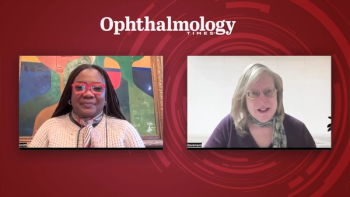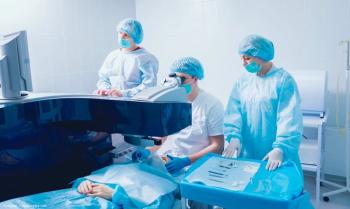
Pre-cut tissue promising technique for DSAEK
The early results after use of pre-cut tissue for Descemet stripping automated endothelial keratoplasty (DSAEK) indicate that there is rapid restoration of good vision with no difference in complications compared with tissue that is cut by the surgeon. The tissue dislocation rate is low (1%), as is the loss of donor endothelial cells.
Key Points
Dr. Terry and colleagues carried out a prospective, non-comparative, interventional case series that included 100 consecutive endothelial keratoplasties using pre-cut tissue. The patients included in the study were a mean age of 71 ± 11 years, and 51% were women. The majority (84%) of patients had Fuchs' dystrophy.
The complications that have been identified with pre-cut tissue are graft dislocations, primary graft failure, and development of pupillary block glaucoma, according to Dr. Terry, who is director of corneal services, Devers Eye Institute, Portland, OR.
The donor tissue was obtained from individuals who were a mean age of 58 ± 11 years (range, 27 to 74 years). The mean time from donor death to preservation of the tissue was 10 ± 3 hours (range, 3 to 18 hours). The mean time from donor death to surgery was 95 ± 36 hours (range, 31 to 165 hours). The mean time from pre-cutting of the tissue to surgery was 26 ± 17 hours (range, 2 to 94 hours). The mean posterior lenticular thickness was 169 ± 36 μm (range: 88 to 257 μm). The mean endothelial cell count after the tissue was pre-cut was 2,709 ± 292 cells/mm2 (range, 2,110 to 3,473 cells/mm2 ).
The only complication associated with using pre-cut tissue for DSAEK in this series of patients was one case (1%) of dislocation. There were no cases of primary graft failure or development of pupillary block glaucoma. The one dislocation occurred as a result of surgeon error in performance of the technique, i.e., eccentric trephination followed by trimming of a thick edge with scissors, Dr. Terry described.
Based on their results, Dr. Terry concluded, "Complications from DSAEK can be avoided by using the proper technique. Dislocations and graft failure in DSAEK surgery are not the result of any specific donor characteristics. The use of pre-cut tissue with a wide range of values is safe for DSAEK," he said.
Of the 100 patients, 45 were evaluated 6 months after surgery. The mean preoperative visual acuity (VA) was 20/61 that improved to a mean postoperative value of 20/33. A total of 82% of patients achieved 20/40 or better, and 20% achieved 20/20 or better, Dr. Terry reported.
The 32 patients with no retinal disease fared better than those with retinal disease. The mean preoperative VA in this subgroup of patients was 20/60 and the mean postoperative VA was 20/27. Of the 32 patients with no retinal disease, 100% had postoperative VA of 20/40 or better, and 28% had 20/20 or better.
Dr. Terry also pointed out that the improvements in vision were not significantly correlated with any donor characteristics.
Newsletter
Don’t miss out—get Ophthalmology Times updates on the latest clinical advancements and expert interviews, straight to your inbox.













































